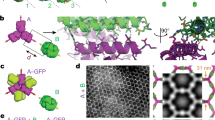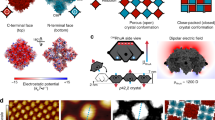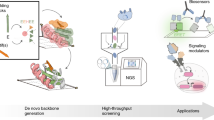Abstract
We developed a high-density self-assembling protein microarray, based on the nucleic acid programmable protein array (NAPPA) concept, to display thousands of proteins that are produced and captured in situ from immobilized cDNA templates. We arrayed up to 1,000 unique human cDNAs and obtained high yields of protein expression and capture with minimal variation and good reproducibility. This method will enable various experimental approaches to study protein function in high throughput.
This is a preview of subscription content, access via your institution
Access options
Subscribe to this journal
Receive 12 print issues and online access
$259.00 per year
only $21.58 per issue
Buy this article
- Purchase on Springer Link
- Instant access to full article PDF
Prices may be subject to local taxes which are calculated during checkout



Similar content being viewed by others
References
MacBeath, G. & Schreiber, S. Science 289, 1760–1763 (2000).
Zhu, H. et al. Science 293, 2101–2105 (2001).
Braun, P. et al. Proc. Natl. Acad. Sci. USA 99, 2654–2659 (2002).
Ramachandran, N. & LaBaer, J. Curr. Opin. Chem. Biol. 9, 14–19 (2005).
Ramachandran, N. et al. Science 305, 86–90 (2004).
Angenendt, P., Kreutzberger, J., Glokler, J. & Hoheisel, J.D. Mol. Cell. Proteomics 5, 1658–1666 (2006).
Tao, S.C. & Zhu, H. Nat. Biotechnol. 24, 1253–1254 (2006).
He, M. et al. Nat. Methods 5, 175–177 (2008).
Murthy, T. et al. PLoS ONE 2, e577 (2007).
Rolfs, A. et al. PLoS ONE 3, e1528 (2008).
Newman, J.R. & Keating, A.E. Science 300, 2097–2101 (2003).
Boutell, J.M., Hart, D.J., Godber, B.L., Kozlowski, R.Z. & Blackburn, J.M. Proteomics 4, 1950–1958 (2004).
Rickman, D.S., Herbert, C.J. & Aggerbeck, L.P. Nucleic Acids Res. 31, e109 (2003).
Arduengo, M., Schenborn, E. & Hurst, R. Cell Free Protein Expression (Landes Bioscience, Austin, Texas, USA, 2007).
Acknowledgements
We thank J. Williamson and M. Fernandez for their help with the robotics and D. Zhu and R. Boyce for developing the DNA normalization tool. This study was supported by the Early Detection Research Network (US National Cancer Institute grant 5U01CA117374-02) and the US National Institute of Allergy and Infectious Diseases (contract HHSN2332200400053C).
Author information
Authors and Affiliations
Contributions
N.R. designed the experiment, processed slides and wrote the manuscript; J.V.R. and G.D. implemented automation, purified and printed DNA; E.H. analyzed array data; M.G.F. tested surface and printing chemistries; Y.H. performed informatics analysis of gene collection; A.R. cloned genes; and J.L. designed the experiment and wrote the manuscript.
Corresponding author
Supplementary information
Supplementary Text and Figures
Supplementary Figures 1–3, Supplementary Methods, Supplementary Protocol, Supplementary Tables 1–3 (PDF 846 kb)
Rights and permissions
About this article
Cite this article
Ramachandran, N., Raphael, J., Hainsworth, E. et al. Next-generation high-density self-assembling functional protein arrays. Nat Methods 5, 535–538 (2008). https://doi.org/10.1038/nmeth.1210
Received:
Accepted:
Published:
Issue Date:
DOI: https://doi.org/10.1038/nmeth.1210
This article is cited by
-
Deep learning based CETSA feature prediction cross multiple cell lines with latent space representation
Scientific Reports (2024)
-
Human antibody profiling technologies for autoimmune disease
Immunologic Research (2023)
-
Supramolecular protein assembly in cell-free protein synthesis system
Bioresources and Bioprocessing (2022)
-
A highly predictive autoantibody-based biomarker panel for prognosis in early-stage NSCLC with potential therapeutic implications
British Journal of Cancer (2022)
-
Identification of anti-Epstein-Barr virus (EBV) antibody signature in EBV-associated gastric carcinoma
Gastric Cancer (2021)



